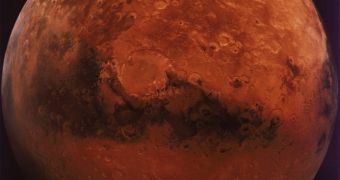Out of about 20 candidates for NASA's next mission to the red planet, the organization selected the Mars Atmosphere and Volatile EvolutioN (MAVEN) spacecraft.
The $485 million project was chosen on grounds like lowest implementation risk and best science value, and it will provide new or additional information on the atmosphere of the red planet, as well as on its climate history and habitability potential. The "scout mission"-type craft will be a great asset to the following more ample undertakings.
Littleton's Lockheed Martin will build the spacecraft based on the previous mission designs of NASA's Mars Reconnaissance Orbiter and 2001 Mars Odyssey. Scheduled for launch in late 2013 and set to reach its intended destination sometime in the autumn of 2014, MAVEN will be placed on an elliptical orbit 90 to 3.870 miles (145 to 6228 km) above Mars' surface.
The planet once had a more dense atmosphere, which allowed the presence of liquid water on its surface, but dramatic climate changes led to the loss of most of it. The spacecraft will get as close as 80 miles (128 km) above the surface in order to draw samples from the atmosphere, and measurements of the current state of the Martian atmosphere may provide hints on the history of the aforementioned phenomenon. Doug McCuistion, the director of the Mars Exploration Program at NASA Headquarters in Washington stated that "The loss of Mars' atmosphere has been an ongoing mystery. MAVEN will help us solve it."
The main investigator in the project, University of Colorado's research department, has been granted $6 million from NASA for technology development and mission planning purposes that will be carried there next year.
The 8 instruments placed on MAVEN will perform measurement activities for an entire year (or for half of a Martian year), and this kind of data will prove fundamental if terraformation ever becomes a real possibility on our red neighbor.

 14 DAY TRIAL //
14 DAY TRIAL //